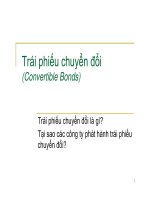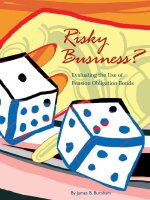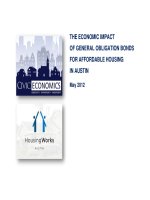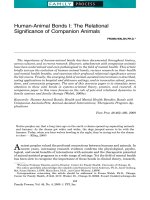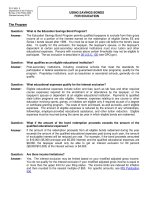Brazilian government bonds
Bạn đang xem bản rút gọn của tài liệu. Xem và tải ngay bản đầy đủ của tài liệu tại đây (877.01 KB, 33 trang )
The Brazilian
Government Bond
Prepared by:
HWA-YOUNG
CHONNY
HUNG
Contents Table
1. Bond overview
2. Introduction of Brazil Economies
3. Brazil goes into recession after World Cup
4. Evaluate Brazilian Government Bonds
5. The outlook of Brazilian Government Bonds in
2015
1- Bond Overview
What is a bond?
•
is a loan that the bond purchaser, or bondholder,
makes to the bond issuer.
•
Like a loan, a bond pays interest periodically
(coupon payment) and repays the principal (Face
Value) at a stated time, known as maturity.
What determines the price of a bond in the
open market?
•
A bond’s price and yield determine its value
in the secondary market.
What determines the price of a bond in the
open market?
•
Example :
- Suppose the fall of the real to 13%, at the
same time Brazilian yield rate is 12%. What
does it mean?
- Investors made a loss
- Real is difficult to hedge and take lots of
cost so is exposed in foreign exchange loss.
Government Bonds
•
issued by a national government when they need
capital.
•
is denominated in the country’s own currency
•
Bonds issued by national governments in foreign
currencies are normally referred to as sovereign bonds
•
Purchased by Central Government at maturity.
•
Examples of government bonds:
- U.S. Treasuries
- Japanese Government Bonds
- Brazilian Government Bonds
Government Bonds
•
The yield required by investors to loan funds to
governments reflects
- inflation rate expectations
- the likelihood that the debt will be repaid
•
Example :
- rapid changes in currency exchange rate
: The real has collapsed and it drives
Brazil economy to
sharp increase in prices
2- Introduction of Brazil Economies - GDP
The GDP in Brazil was worth 2245.67 billion US dollars in 2013.
The GDP value of Brazil represents 3.62% of the world economy.
GDP in Brazil averaged 536.88 USD Billion from 1960 until 2013, reaching
an all time high of 2476.69 USD Billion in 2011 and a record low of 15.17
USD Billion in 1960.
Brazil GDP Annual Growth Rate Chart(1991-2015)
GDP contracted 1.60% in the first quarter of 2015 over the same
quarter of the previous year.
GDP Annual Growth Rate in Brazil averaged 2.93% from 1991 until
2015.
reaching an all time high of 10.10%in 1995,record low of -3.15%in
1992.
Brazil GDP Per Capita
The GDP per capita was last recorded at 5823.04 US dollars in 2013.
The GDP per Capita in Brazil is equivalent to 46% of the world's
average. GDP per capita in Brazil averaged 3791.85 USD from 1960
until 2013.
reaching an all time high of 5823.04 USD in 2013 and a record low of
1726.57 USD in 1960.
3- Recession
Brazil goes into recession for first time in over 5 years
after World Cup.
GDP falls
Investment Drop
Credit Rating: Standard &Poor's in March, 2014 lowered
its debt rating on Brazil.
Economic output, GDP, fell by 0.6% in the three months to June, worse
than analysts had predicted, and revised figures for the first quarter of the
year also showed a fall of 0.2%.
Brazil GDP Annual Growth Rate
4- The current risk factors associated with Brazilian
Government Bonds 10Y & its implications
Issuance of Brazilian global bonds reached USD40bn in 2010.
Brazilian Global Bonds 10Y
Government ($2.8 bn)
Financial Sector
($17.2bn)
Corporates ($19.8bn)
Bond Yield
-
Decreased to 12.28 percent in May from 12.80
percent in April of 2015.
-
Averaged 12.28 from 2006 until 2015.
CURRENT RISK FACTORS
Evaluate the current risk factors associated with Bra.
Gov’t Bond and their current price:
- Credit Rating Risk Factor
- Interest Rate Risk Factor
- Inflation Rate Risk Factor
- Exchange Rate Risk Factor
- Liquidity Risk Factor
CURRENT RISK FACTORS
Credit Rating Risk Factor
-The bond issuer may experience financial problems that
make it difficult or impossible to pay interest and principal in
full (default).
- Credit ratings seek to estimate the relative credit risk of a
bond as compared with other bonds.
Credit Rating Risk Factor
- BGB was ranked medium credit-quality investment grade (a
step above junk bond).
- Having ADEQUATE capacity to meet its financial commitments.
However, adverse economic conditions or changing circumstances
are more likely to lead to a weakened capacity of the obligor to
meet its financial commitments.
Interest Rate Risk Factor
- Recorded at 13.25% on 2014/05/30.
- Averaged 15.74 percent from 1999 until 2015.
- If the interest rate rises, bond price falls.
Inflation Rate Risk Factor
- Recorded at 8.17 percent in April of 2015.
- Inflation reduces purchasing power, which is a risk for
investors receiving a fixed rate of interest.
- Lead to higher interest rates & lower market value for
existing bonds.
Exchange Rate Risk Factor
-
The Brazilian real (R$) is the worst performing BRIC
currency against the dollar this year.
-
If the R$ become weaker, the bond price will lower.
Liquidity Risk Factor
-
Because of all of risk factors above, investors cannot
sell the bonds whenever they want.
-
The higher other risk factors, the higher liquidity risk.
CONCLUSION OF RISK FACTORS
- Credit Rating: at lower medium grade
(above junk bond)
- Interest Rate: at 13.25% - very high
- Inflation Rate: at 8.17% - high
- Exchange Rate: R$ become more & more weaker
- Liquidity : low liquidity
Conclusion:
All of factors above lead the Brazilian Gov’t Bond into lower
& lower price day by day.
5- The outlook of Brazilian Gov’t. Bond in 2015
Forecast the outlook of risk factors below to evaluate the
perspective of Bra. Gov’t. Bond to the end of 2015.
- Credit Rating Risk Factor
- Interest Rate Risk Factor
- Inflation Rate Risk Factor
- Exchange Rate Risk Factor
5- The outlook of Brazilian Govt. Bond in 2015
- Inflation Rate still go up at the end of 2015
